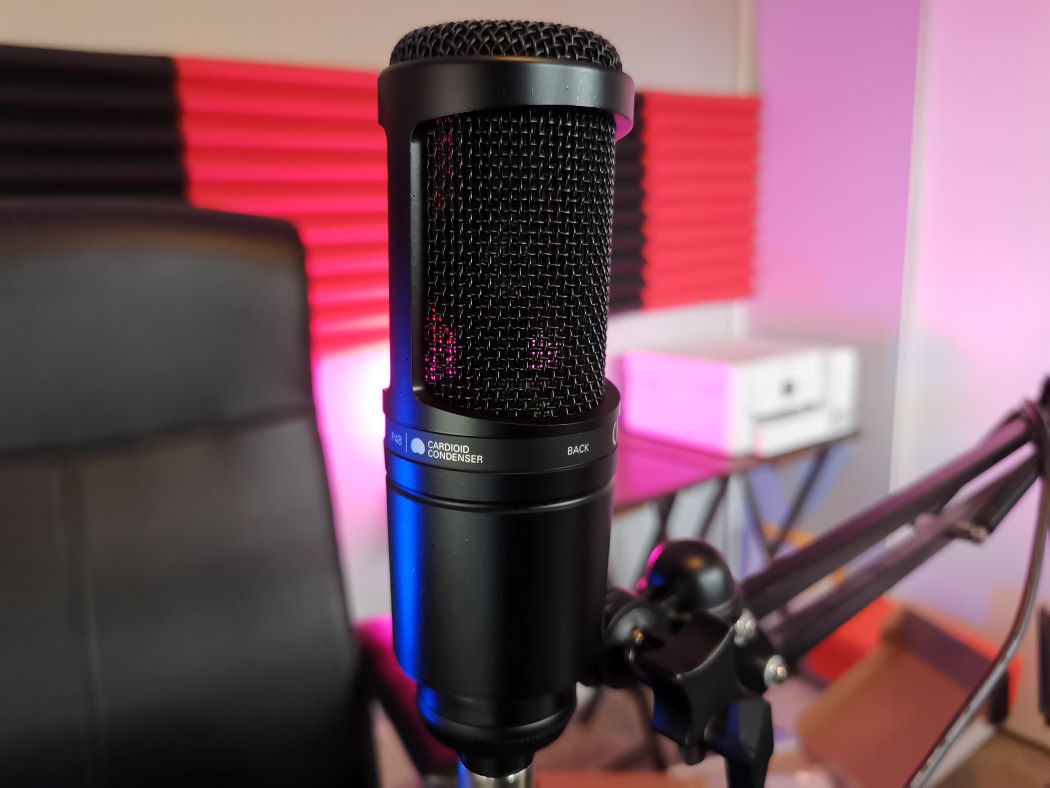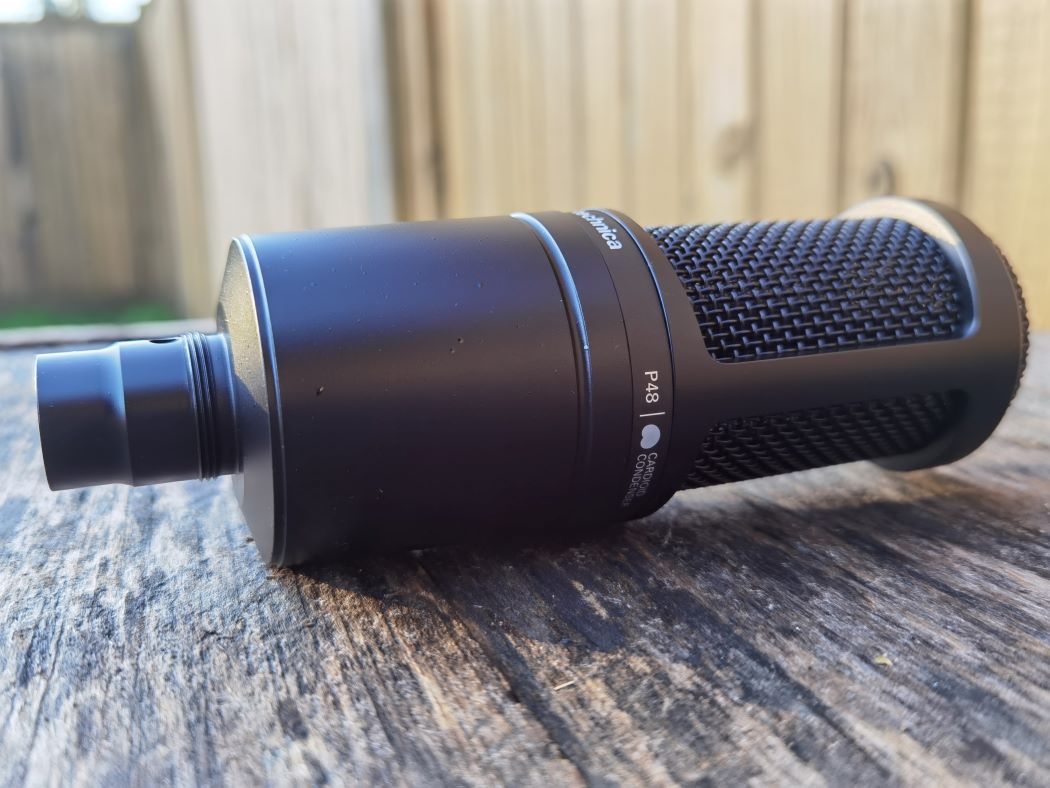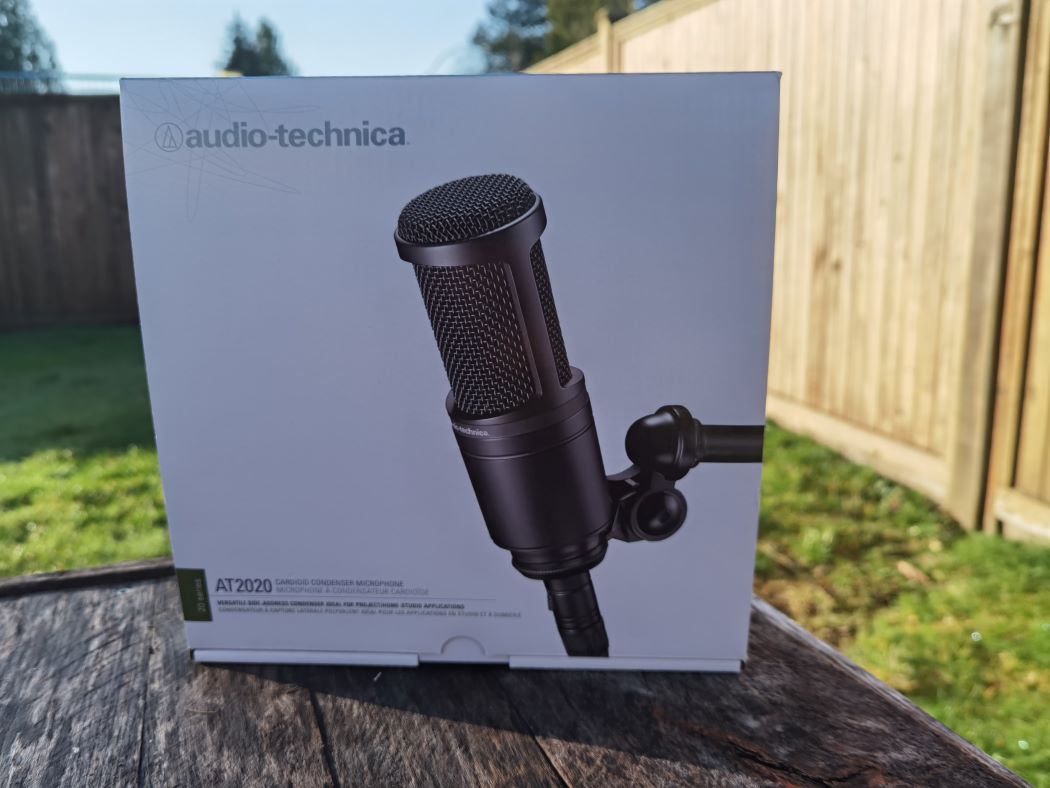
With my background in music production, I absolutely love recording equipment. My love and interest in technology really started in a recording studio. So when I talk to content creators, I always ask them about the equipment they use, and why.
Today I’m reviewing a condenser microphone from Audio Technica, the AT2020 Cardioid Condenser Microphone. This is a budget-friendly microphone perfect for musicians, podcasters, VO artists, and radio professionals.
If you want to get the most bang for your buck, this workhorse microphone might be for you. Be advised, it’s a condenser microphone so it will require phantom power. Since I don’t think a lot of people know the difference between dynamic and condenser microphones, let’s start there.
Dynamic vs condenser microphones
There are two main types of microphones, dynamic, and condenser. Dynamic microphones are used mostly in live settings like shows or events. They have a relatively simple construction and can handle high sound levels.
Condenser microphones use an electrically-charged diaphragm and require a 48V power source. This can be done with batteries or by phantom power, a method of supplying power through a microphone cable. Condenser microphones are typically used in studio settings to record vocals, either singing or spoken word for radio or podcasts.
Since they use 48V phantom power, all condenser microphones create some signal noise. I own some really cheap condenser microphones and they create a lot of noise that sounds like a low hiss. A well-designed condenser microphone will have low signal noise. That’s the big difference I’ve seen between budget and high-end models.
With that in mind, let’s begin by examining the design of the AT2020 condenser microphone.
Design of the Audio Technica AT2020 microphone
Microphones are typically used in a studio, or on the road. In both cases, they need to be made tough. With an all-metal build and metal grille, this microphone has a solid construction. I especially like how the metal frame sits on top of the grille. This protects the microphone from drops and knocks without hitting the grille itself. A truly great design feature.
Weighing about 12oz, the AT2020 is compact in size measuring approximately 9.5 inches long and 2.5 inches wide. The threaded stand mount pivots and can be detached. It provided a secure placement on my microphone stand and was stable throughout.
There’s also a secondary layer of finer mesh under the metal grille. This helps reduce popping sounds. I still use an external pop shield, and I recommend others do the same. There are just some things you can’t fix in an edit, pop sounds are one of them.
While some condenser microphones have USB connections, this one uses a standard XLR cable which is not included. It does, however, come with a small leather pouch.
Using the Audio Technica AT2020 microphone
It’s hard to assess the quality of a microphone without testing it against others. Thankfully, I just happen to have a super cheap condenser microphone, and a high-end mic to compare against. I recorded my own voice with each microphone and then listened back to hear the differences.
The AT2020 has a maximum SPL rating of 144 dB. SPL stands for Sound Pressure Level and indicates the highest pressure level a mic can handle before the onset of distortion. This tells me that this mic can handle all types of sound sources ranging from horns, drums, and vocals.
I adjusted the gain levels and it could record whispers and loud talking. Without using my pop shield, I could still hear some pop sounds. This is why I always recommend pop filters in studio settings.
Without any effects like compressors or eq, I felt that it captures clean vocal takes. Most people do not like hearing their own voice. I found the recordings with the AT2020 were flattering as my voice sounded, warm, smooth, and well-balanced.
Recording with the Audio Technica AT2020 microphone
The AT2020 has a very modern sound. Not only is it bright, but pairing it with different preamps gives it different colours. Some people might find the high frequencies to be overhyped. In that sense, it does not sound like a vintage microphone. Singers will like it because it helps vocals cut through a mix.
I was also impressed with the cardioid pickup pattern which rejected unwanted sounds from the sides and the rear. This makes it suitable for recording vocals in a home studio. The fan sound in most computers would likely not bleed into a recording.
I didn’t record any instruments but based on my vocal recordings, it would be suitable to record acoustic guitars. The microphone placement would be critical, as it’s pickup pattern is designed to record head-on.
Final thoughts
For anyone on a budget, the Audio Technica AT2020 is a great value microphone. It’s perfect to record vocals, either spoken word or singing in a home studio. However, since it has an XLR connection, you will need an audio interface to connect it to a computer. It also doesn’t come with a shock mount. Once you use a microphone in a shock mount, you understand why it’s always used in professional settings.
Being budget-friendly, it does not have some features you see in high-end microphones. For example, it does not have a polar pattern selection switch or roll-off filter. That’s why I think this mic is best suited for vocals and acoustic guitars.
It produced self-noise, which I expected. This is noticeable during silent breaks. However, there are excellent noise reduction tools that can eliminate self-noise. With these tools, I was able to eliminate the hiss that my cheap microphones produce. Users could definitely do the same with this microphone if the self-noise became an issue.
Still, it really did exceed my expectations, especially at its price point. It has a quality build, sounds bright, and works perfectly for vocal recording. Other than the self-noise, there’s really no other fault with this microphone. If you need to record vocals and you’re on a budget, the Audio Technica AT2020 Cardioid Condenser Microphone should certainly fit the bill.





